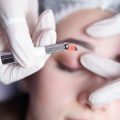Understanding Multicultural Skin Types in the UK
The United Kingdom is renowned for its rich cultural diversity, reflected not only in its vibrant communities but also in the wide spectrum of skin types seen across the population. Navigating post-treatment aftercare in such a multicultural context requires a nuanced understanding of the unique characteristics that different ethnic backgrounds present. British residents may have ancestry from Europe, South Asia, Africa, East Asia, the Middle East, or mixed heritage, each bringing distinct skin properties and potential responses to aesthetic or dermatological treatments. Central to clinical assessment is the Fitzpatrick skin type classification, which spans from Type I (very fair, always burns) to Type VI (deeply pigmented dark brown or black skin, never burns). In the UK, while lighter Fitzpatrick types are prevalent among those with European heritage, there is a significant presence of Types IV to VI among Black British, South Asian, and mixed-race individuals. This diversity impacts not only baseline skin behaviour but also susceptibility to post-treatment complications such as hyperpigmentation, scarring, or delayed healing. Recognising and respecting these variations forms the foundation for safe and effective aftercare strategies tailored to Britain’s multicultural landscape.
Common Post-Treatment Concerns and Complications
When considering post-treatment aftercare for multicultural skin in the UK, it is vital to address typical concerns that may arise following aesthetic or dermatological procedures. Individuals with skin of colour—encompassing Black, Asian, Middle Eastern, and mixed ethnic backgrounds—may experience distinctive reactions compared to lighter skin types. Here, we explore the most prevalent post-procedure complications and their particular relevance to the UKs diverse population.
Key Post-Procedure Reactions
| Concern | Description | Prevalence in Skin of Colour |
|---|---|---|
| Hyperpigmentation | Darkening of the skin at the treatment site, often as a result of inflammation or injury. | Higher risk; increased melanin activity makes this a significant issue in darker skin tones. |
| Scarring (Keloids/Hypertrophic) | Excessive fibrous tissue formation leading to raised scars, sometimes extending beyond the original wound. | More common in individuals with African, Caribbean, and South Asian heritage. |
| Sensitivity/Irritation | Redness, swelling, or stinging sensation after procedures such as chemical peels or laser treatments. | Darker skin may exhibit prolonged erythema and delayed healing responses. |
Why Are These Concerns More Pronounced?
The unique physiological characteristics of darker skin types include higher melanin content, increased fibroblast reactivity, and a propensity towards certain inflammatory responses. These features contribute to an elevated risk of pigmentary changes and abnormal scar formation following aesthetic interventions. Additionally, multicultural patients residing in the UK may be more susceptible due to environmental factors like lower sunlight exposure and differences in healthcare access or practitioner awareness.
Cultural Awareness in Aftercare Protocols
Recognising these risks is crucial for practitioners when advising on aftercare. Tailored protocols should be established to mitigate complications, including using gentle skincare products, avoiding harsh chemicals, and providing specific guidance on sun protection—even in the UK’s temperate climate. Addressing these concerns proactively fosters better outcomes and patient satisfaction across all ethnic groups.

3. Tailoring Aftercare to Individual Skin Needs
Recognising the rich tapestry of multicultural skin in the UK, post-treatment aftercare must be meticulously tailored to individual needs.
Personalising Protocols for Diverse Skin Physiology
Skin physiology varies significantly across ethnic backgrounds, with differences in melanin content, barrier function, and healing responses. It is crucial for practitioners to assess each patient’s unique skin type—whether Fitzpatrick IV-VI or lighter tones—and adapt aftercare protocols accordingly. For example, patients with higher melanin levels may be more susceptible to post-inflammatory hyperpigmentation (PIH) after procedures such as chemical peels or laser treatments. Therefore, gentle topical agents, sun avoidance strategies, and pigment-safe products should be prioritised.
Culturally Sensitive Recommendations
The cultural context of skincare cannot be overlooked. Many patients may use traditional remedies or prefer specific product types due to heritage or religious beliefs. Open dialogue about these preferences ensures recommendations are both effective and respectful. Practitioners should be prepared to suggest fragrance-free, halal-certified, or vegan-friendly options where relevant, and provide clear rationale for avoiding certain home remedies that could impede recovery.
Addressing Language and Communication Barriers
Effective communication underpins successful aftercare. In the UK’s multicultural environment, language barriers can hinder understanding of complex post-procedure instructions. Clinics should offer translated materials, utilise visual aids, or collaborate with interpreters when necessary. Moreover, using plain English and confirming patient comprehension through teach-back methods reduces the risk of miscommunication and ensures adherence to aftercare protocols.
By personalising aftercare in this way—considering physiological differences, cultural sensitivities, and communication needs—clinics across the UK can deliver safer and more effective outcomes for their diverse patient base.
4. Evidence-Based Product Recommendations
Post-treatment aftercare for multicultural skin in the UK necessitates a careful selection of products that respect diverse skin tones and unique dermatological needs. The efficacy and safety of emollients, sun protection, and topical treatments can vary according to skin type and pigmentation, making evidence-based choices essential.
Recommended Emollients for Multicultural Skin
Emollients play a pivotal role in maintaining barrier function following aesthetic or dermatological treatments. For darker skin tones, options with minimal fragrance and non-comedogenic properties are particularly important to reduce irritation and prevent hyperpigmentation. UK pharmacies stock a range of suitable emollients:
| Product | Key Features | Skin Type Suitability | Availability (UK) |
|---|---|---|---|
| Cetraben Cream | Fragrance-free, moisturising, suitable for sensitive skin | All tones, especially dry/sensitive | NHS prescription & OTC |
| Epaderm Ointment | No colourants or fragrances; intensive hydration | Darker tones prone to ashy appearance | Pharmacies & online retailers |
| Aveeno Daily Moisturising Lotion | Oat-based, gentle formula | Light to medium tones; eczema-prone skin | Supermarkets & pharmacies |
Sun Protection: Essential for All Tones
While higher melanin offers some natural UV protection, post-treatment skin across all tones is more susceptible to photodamage and post-inflammatory hyperpigmentation. Broad-spectrum sunscreens with SPF 30+ are universally recommended. Importantly, formulations without white cast are preferred for deeper complexions:
| Sunscreen Brand/Type | Main Benefits | Tone Compatibility | Where to Buy (UK) |
|---|---|---|---|
| La Roche-Posay Anthelios UVMune 400 Invisible Fluid SPF50+ | No white residue, lightweight texture | All tones, especially darker skin | Boots & Superdrug stores |
| Black Girl Sunscreen SPF 30/50* | No white cast, moisturising, designed for deeper tones* | Darker skin types* | *Limited UK stockists; available online* |
| Eucerin Sun Gel-Cream Oil Control SPF50+ | Non-greasy, suits oily/acne-prone skin | Light to medium tones; suitable for Asian/BAME groups | Lloyds Pharmacy & online retailers |
Topical Treatments: Caution and Customisation
The use of active ingredients like retinoids or hydroquinone post-procedure should be approached cautiously in darker skin due to increased risk of PIH (post-inflammatory hyperpigmentation). Pharmacy professionals in the UK recommend starting with low concentrations and patch testing. For pigment correction or calming inflammation:
- Azelaic Acid (e.g., Finacea): Mildly brightens uneven tone; suitable for all ethnicities.
- Niacinamide Serums: Eases redness and regulates oil without irritation; widely available at Boots/Superdrug.
- Aloe Vera Gels: Offers immediate soothing; ideal for sensitive or recently treated skin.
Pharmacy Advice Across the UK
NHS pharmacists provide culturally competent guidance on product selection and usage instructions. Community pharmacies frequently offer private consultations—particularly valuable for patients concerned about keloid formation or pigment changes post-procedure. Wherever possible, opt for UKCA-marked products or those recommended by the British Association of Dermatologists.
*Note on Product Availability*
The above recommendations reflect widely available options within the UK market as of 2024, but availability may vary regionally or due to supply chain factors. Always consult local pharmacy teams for up-to-date advice tailored to individual aftercare needs.
5. Cultural Practices and Patient Education
In the context of post-treatment aftercare for multicultural skin in the UK, it is essential to acknowledge and respect the diverse traditional and cultural skincare practices that patients may follow. The UKs rich multicultural society means practitioners frequently encounter a wide array of beliefs, routines, and expectations surrounding skin health. This diversity necessitates a tailored approach to patient education, ensuring that aftercare recommendations are both effective and culturally sensitive.
Acknowledging Traditional Skincare Practices
Many communities across the UK adhere to longstanding skincare rituals, ranging from the use of herbal remedies and oils to specific cleansing techniques passed down through generations. For instance, some South Asian patients may favour turmeric-based treatments, while those from African or Caribbean backgrounds might rely on shea butter or natural oils. Understanding these practices allows clinicians to engage with patients more empathetically and avoid recommendations that could conflict with their traditions.
Navigating Potential Conflicts
It is important for practitioners to identify any traditional products or routines that could interfere with modern clinical aftercare protocols. Certain herbal preparations might increase skin sensitivity or interact negatively with prescribed topical medications. By initiating open conversations about these habits, clinicians can better advise on which elements should be paused or modified during the recovery period without dismissing the cultural significance attached to them.
Patient Education within Cultural Contexts
Effective patient education goes beyond simply providing standardised aftercare instructions. It involves adapting communication strategies to align with each patient’s cultural background and language preferences where possible. For example, using analogies or explanations that resonate with specific community values can improve understanding and adherence. Furthermore, providing translated materials or access to interpreters ensures clarity, particularly for recent immigrants or older adults who may not be fluent in English.
Building Trust through Cultural Sensitivity
By demonstrating genuine respect for cultural norms and showing flexibility in incorporating safe traditional practices into post-treatment regimens, practitioners can foster stronger patient relationships. This trust is crucial in encouraging ongoing engagement with professional advice and achieving optimal treatment outcomes. Ultimately, a culturally attuned approach to aftercare not only supports individual well-being but also reflects best practice standards within the UK’s dynamic healthcare environment.
6. Ensuring Inclusive Clinical Environments
Creating an inclusive clinical environment is essential for delivering optimal post-treatment aftercare to clients with multicultural skin in the UK. Clinics must prioritise staff training focused on cultural competence, ensuring that all team members understand the unique physiological and cultural considerations associated with diverse skin types.
Staff Training for Multicultural Sensitivity
Effective aftercare begins with a well-informed team. Clinics should invest in regular training sessions that cover the latest research on skin health across different ethnicities, common concerns such as hyperpigmentation or keloid scarring, and culturally appropriate communication styles. Encouraging open discussion about biases or misconceptions also fosters a more empathetic approach to client care.
Cultural Competence in Clinical Practice
Cultural competence extends beyond basic awareness—it involves actively recognising and respecting the values, beliefs, and practices of clients from various backgrounds. This includes being sensitive to religious requirements, language barriers, and individual preferences regarding modesty during treatments and follow-up visits. Providing translated aftercare instructions or employing multilingual staff where possible can significantly enhance client satisfaction and safety.
Building a Supportive Environment
An inclusive clinic environment is one where every client feels valued and understood. This can be achieved by creating feedback mechanisms for clients to share their experiences, displaying inclusive imagery within the practice, and implementing policies that protect against discrimination. Regularly reviewing these practices ensures ongoing relevance and effectiveness in meeting the needs of a multicultural population.
By embedding cultural competence at every level, UK clinics can ensure that post-treatment aftercare is not only clinically effective but also culturally respectful—ultimately supporting better outcomes for all clients.


